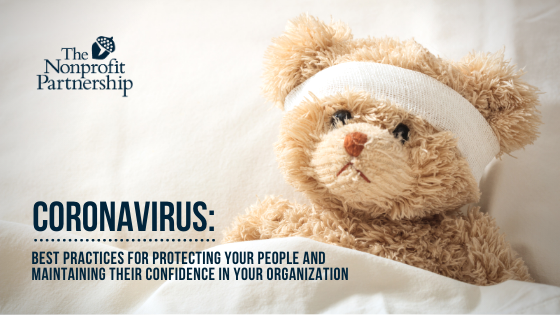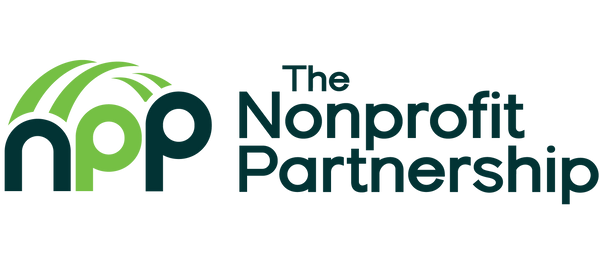
Unless you’ve been sequestered in a submarine at the bottom of the sea since Thanksgiving, you’re well aware of the looming public health threat of COVID-19, known colloquially as the coronavirus. And if, like me, you’re being fed a steady stream information about the coronavirus throughout the day (and night) via push notifications, the radio, social media, the TV at the oil change joint, and idle chit-chat in every place where adults that speak the same language congregate, news about the spread of the virus and its implications can feel overwhelming. If I’m supposed to prepare for the possibility of “severe” disruptions to my daily life, how’s my organization going to weather this?
Good news: the CDC has published interim guidance for employers on how to best protect their clients, constituents, and staff. Some key directives from the guide include:
Educate employees about how to stay safe.
Empower your staff with information on how to maintain proper hygiene. This includes sharing information on hand washing and cough/sneeze etiquette, either via email or through posters placed in restrooms, kitchens, and elsewhere.
According to a 2018 USDA study on pre-meal handwashing, 97% of people don’t wash their hands “correctly” – they’re not washing them for long enough or they’re not using a clean towel to dry them off. That’s why I’m a big fan of this handwashing sign from the CDC that provides a five-step guide to proper hand washing technique.
Ensure your organization’s offices and facilities are cleaned regularly and cleaned well.
Work with your cleaning company or cleaning staff to ensure that all high-touch areas in your workplace are being cleaned with appropriate cleaners on a regular basis. Light switches, door knobs, countertops, you name it. The CDC also recommends providing disposable wipes to employees so they can clean “commonly used surfaces” like keyboards, door knobs, and remotes before each use.
Encourage employees to take time off or work from home if they need to!
This is perhaps the most significant step you can take to keep your people safe. Employers should actively encourage any employees showing signs of illness to stay home.
The CDC suggests placing posters encouraging sick employees to stay home in common areas; making sure your organization’s sick time policies are “flexible and consistent with public health guidance”; making sure that employees are aware of your organization’s sick time policies; having a discussion with any partner agencies, vendors, or contractors about their sick time policies, ensuring they’re also following best practice; and forgoing the requirement that sick employees provide doctor’s notes, if applicable.
You may think that your employees are well aware of your organization’s sick time policies – but then again, you also thought you were washing your hands correctly.
Even if employees are aware of your sick time policies, they may not feel like they’re in a position to take advantage of them. (For many part-time, seasonal, and temporary employees, it’s not about feeling – they simply don’t have sick time. More on that later.) The same culture that encourages us to wear busyness as a badge of honor produces people that show up to work, sneezing and sniffling as they trudge from desk to coffee pot to conference room (all places we should be wiping down regularly, as we’ve learned), so that they can congratulate themselves for not letting the reality of having a body get in the way of their work. Get enough people with this mindset in the same place demonstrating these values and culture will quickly supersede whatever’s in your employee handbook.
To combat this cultural programming, it is incumbent upon employers to, first, make it absolutely, unquestionably, crystal clear that employees that are sick should stay home and, second, to immediately send home employees that show signs of illness or fever.
Another option is to implement a work from home policy for employees who may be showing signs of sickness but aren’t so down-for-the-count that they can’t still work. This way, employees will still have sick time available for instances when they’re truly out of commission.
For employees that simply don’t have sick time, it’s a different story. Their hesitation about taking time off has less to do with culture and more to do with the fact that not being at work means not getting paid – not being able to buy groceries, not being able to put gas in the car. So what’s the solution there?
Let’s circle back to the second recommendation in the HR portion of the CDC’s interim guidance for businesses: making sure that your organizations’ sick time policies are “flexible and consistent with public health guidance.”
If you’re one of the many organizations that doesn’t offer sick time to all employees, now is the time to do some reevaluating.
In the face of a viral outbreak that has the potential to become a pandemic, your organization needs to take active, substantative steps to help your employees make smart choices – staying home when they’re sick, for one – especially if employees are working with clients or constituents in a healthcare or eldercare setting where they’re virtually guaranteed to have direct contact with the populations at greatest risk of death from COVID-19, including the elderly and people with comorbidities like “cardiovascular diseases, diabetes, hepatitis B, chronic obstructive pulmonary disease, chronic kidney diseases, and cancer,” just to name a few. (Really, this goes for everyone at every organization, because community spread is a significant threat, but people with direct contact with vulnerable populations deserve extra emphasis.) That goes for employees that don’t currently have access to sick time, too.
What does that look like for your organization? Maybe it means instituting some kind of temporary sick leave or work from home policy in the immediate future, then rewriting the employee handbook to include sick time for all employees and a work from home policy for some employees going forward. Ultimately, that’s for your leadership team, your HR department, and your Board to decide. But no matter what action you take, the goal should be to help all employees make smart choices, like staying home when they’re sick, for the benefit of their peers and the communities your organization serves.
---
Refer to the CDC’s Interim Guidance for Businesses and Employers for a full list of ways in which your organization can protect its people.
---
Now that you’re well on your way to preparing your organization for COVID-19, you need to communicate what exactly you’re doing to minimize the risk of exposure to your people in order to maintain their confidence in your organization.
For clients and constituents, consider sending an email or a letter acknowledging the situation and detailing the steps your organization is taking to proactively address it, including details about how you’re taking those steps. (A post on your social media channels is a good idea, too.) Who exactly receives this communication at your discretion – but, at the very least, you should include 1.) anyone who may visit your offices or facilities and 2.) anyone who may come into contact with your staff in order to receive your organization’s services.
If you’re planning to introduce new work from home and sick leave policies for your employees (hint, hint), let your clients know, and let them know that these steps are being taken with their wellbeing in mind. When you say you’re planning to maintain a clean and safe environment, say you’ll do so as outlined in the CDC’s interim guidance for businesses, or share that you’re committed to Cloroxing the waiting rooms x times per week. It’s cliché, but it’s true: knowledge is power and communication is key.
You should also provide the contact information of a staff person (or more, if appropriate) that people can reach out to if they have questions about your organization’s response. Make sure this person has been briefed on how to answer questions in an appropriate, knowledgeable, and confidence-inspiring manner – that means no tepid “I don’t know”s or non-answers. This person is representing your organization (and the competence of its management and staff) at a critical juncture – when a concerned person calls to find out if they can trust you, your services, your people. Make sure they have the information and coaching they need to represent your organization well.
Finally, empower your clients and constituents with information by connecting them to additional resources on how the can best protect themselves. (This means resources from the CDC, WHO, or another well-regarded public health agency – absolutely no “articles” from healthvibenow.co.uk that you saw on Facebook.) The CDC has a comprehensive COVID-19 page with information about the virus, how people can protect themselves, considerations for specific groups, and much more. Maybe you want to go the extra mile and include the contact information for the nearest health department – that’s great, too. Either way, providing a next step for your reader is an excellent move.
After sharing a direct communication, you might also consider posting notices with information your organization’s response near public entrances to your office or facility – something short and sweet that conveys the basics: we’re taking this seriously and here’s what we’re doing. You should also place posters about handwashing in client restrooms and posters about cough/sneeze hygiene in waiting rooms or common areas – you get the idea. The point isn’t to paper your walls with public health information or to whip people into a frenzy, only to make it plain as day that your organization cares about the health and safety of your people and that you want them to know you’re taking appropriate measures to protect them.
For employees, adopt a similar approach. Make sure you communicate your organization’s response to COVID-19 in a clear, direct way; this can be coupled with the educational information and directives you’re sharing with them as outlined above and in the interim guidance so that employees have a healthy appreciation for the part they play in the equation.
You should also make sure that employees know who they can go to with questions – and make sure that person is well-equipped to answer those questions in an effective, confidence-inspiring way.
---
If you’re now concerned about the perverse incentive for employees that aren’t granted sick time (or don’t feel like they can take it) to come to work when they’re coughing, sniffling, and contagious; if you’re now mentally calculating who could actually work from home, at least once in a while, now that you think of it, given the nature of their responsibilities; if you’re now wondering if you have the current email addresses of your clients and constituents, all in one place and organized in such a way that you can appropriately segment your communications to them… don’t let a crisis go to waste.
At the end of the day, you want to make sure that your organization is well-positioned to handle a crisis like COVID-19 in a way that preserves the health and safety of its people and the organization’s reputation. But let this be an opportunity, too, to take a closer look at what’s often taken for granted during business as usual.
If you aren’t already offering all employees the opportunity to accrue sick time, why not? If you don’t already have some kind of work from home policy for employees whose responsibilities would make that possible, why not? If you’re not collecting and organizing your contact information effectively, why not? Use your organization’s response to COVID-19 as a jumping-off point to expand your imagination and improve upon your organization’s existing policies and processes.
And wash your hands.
---
What is your organization doing to prepare for COVID-19? Let us know. Email me at eyates@yournpp.org.
---
Further Reading:
- Coronavirus Digital Information Portal (Nonprofit HR)
- Interim Guidance for Businesses and Employers (CDC)
- About Coronavirus Disease 2019 (COVID-19) (CDC)
- COVID-19: What Nonprofits Need to Know (Minnesota Council of Nonprofits)
- 8 Questions Employers Should Ask About Coronavirus (Harvard Business Review)
- How Businesses Should Handle the Coronavirus Outbreak (Entrepreneur)
- How to Reassure Your Team When the News Is Scary (Harvard Business Review)

